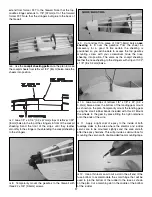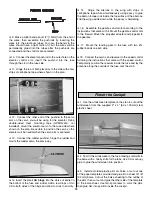
No matter if you fly at an AMA sanctioned R/C club site or if you
fly somewhere on your own, you should always have your
name, address, telephone number and AMA number on or
inside your model. It is
required
at all AMA R/C club flying sites
and AMA sanctioned flying events. Fill out the identification tag
on the back cover and place it on or inside your model.
Before flying you should perform one last overall inspection
to make sure the model is truly ready to fly and that you
haven’t overlooked anything. If you are not thoroughly
familiar with the operation of R/C models, ask an
experienced modeler to perform this inspection. Check to
see that the radio is installed correctly and that all the
controls are connected properly. The motor must also be
checked by confirming that the prop is rotating in the correct
direction and the motor sounds like it is reaching full power.
Make certain all control surfaces (elevators, rudder,
ailerons-if used) are secure, the pushrods are connected,
the controls respond in the correct direction, radio
components are securely mounted, and the C.G. is correct.
Ground check the operational range of the radio before the
first flight of the day. With the transmitter antenna collapsed
and the receiver and transmitter on, you should be able to
walk at least 100 feet away from the model and still have
control. Have an assistant stand by the model and while
you work the controls, tell you what the control surfaces are
doing. Repeat this test
with the motor running
at various
speeds. If the control surfaces do not respond correctly,
do
not fly!
Find and correct the problem first. Look for loose
servo connections or broken wires, corroded wires on old
servo connectors, poor solder joints in your battery pack or
a defective cell, or a damaged receiver crystal from a
previous crash.
For the longest flight duration, and to get the most from a new
battery, the battery should be cycled. “Cycling” a battery means
to fully charge (“peak” charge) the battery, then to discharge it.
Many battery chargers have peak charging and automatic
discharging capabilities. If you do not have a charger that is
able to discharge batteries, you can discharge the battery
yourself by running the motor with the propeller attached until
the propeller barely continues to turn. Charge and discharge
the battery 3 or 4 more times on the ground before flying. Be
sure to remove the battery from the airplane between each
cycle and allow it to cool before recharging.
Use fine sandpaper to remove imperfections along the
edges of the propeller. For the best performance, use a Top
Flite Precision Magnetic Prop Balancer™ (TOPQ5700) to
balance the propellers (this is a necessity on glow-powered
engines, but is less critical on small electric models).
Make two more long rubber bands by connecting two sets
of two #32 rubber bands. Mount the wing with all four rubber
bands criss-crossing the last two.
1. Using multiple battery packs for successive flights may
cause the motor to become excessively hot, thus causing
damage. Allow the motor to cool for at least 10 minutes
between flights.
2. The ideal power source for the Li’l Poke system is a 7 or
8-cell (8.4 - 9.6volt) battery pack. The use of a higher voltage
battery may reduce motor life.
If taking off from the ground, the wheels must spin freely.
Put a drop of oil on each axle and check the wheels for
binding when moved from side to side.
Note:
Failure to follow these safety precautions may result
in severe injury to yourself and others.
Get help from an experienced pilot when learning to operate
the motor.
Use safety glasses when running the motor.
Do not run the motor in an area of loose gravel or sand; the
propeller may throw such material in your face or eyes.
Keep your face and body as well as all spectators away from
the path of the propeller as you start and run the motor.
Keep items such as these away from the prop: loose
clothing, shirt sleeves, ties, scarfs, long hair or loose objects
(pencils, screw drivers) that may fall out of shirt or jacket
pockets into the prop.
MOTOR SAFETY PRECAUTIONS
Oil the Wheels
Motor Care
Mount the Wing
Examine the Propeller
Cycle the Batteries
PERFORMANCE TIPS
Range Check
Ground Inspection
Identify Your Model
22



















